The Impact of Acquisition Date on the Prediction Performance of Topsoil Organic Carbon from Sentinel-2 for Croplands
Abstract
1. Introduction
2. Materials and Methods
2.1. Study Area: The Versailles Plain
2.2. Sentinel-2 Time Series
2.3. Soil Samples
2.4. Information on Disturbing Factors According to Date
2.4.1. Time-Series of Soil Roughness Maps
2.4.2. Soil Moisture Measurements and Soil Moisture Index
2.5. Spectral Models of SOC Content Prediction
3. Results
3.1. Variations in Prediction Performance According to Date
3.2. The Influence of Acquisition Condition
3.3. The Influence of NDVI Threshold
3.4. The Influence of Soil Surface Roughness
3.5. The Influence of Soil Moisture
4. Discussion
4.1. Optimal Dates for Predicting SOC from S2 Images and the Benefit of S2/S1 Synergy
4.2. The Need for Further S1-Derived Soil Moisture Information
4.3. The Assumption of No or Few Crop Residues on the Surface
4.4. The Influence of the Spatial Level of Atmospheric Correction and Dataset Composition
5. Conclusions
Author Contributions
Funding
Acknowledgments
Conflicts of Interest
References
- Minasny, B.; Malone, B.P.; McBratney, A.B.; Angers, D.A.; Arrouays, D.; Chambers, A.; Chaplot, V.; Chen, Z.-S.; Cheng, K.; Das, B.S.; et al. Soil carbon 4 per mille. Geoderma 2017, 292, 59–86. [Google Scholar] [CrossRef]
- Arrouays, D.; Horn, R. Soil Carbon—4 per Mille—An introduction. Soil Tillage Res. 2019, 188, 1–2. [Google Scholar] [CrossRef]
- Soussana, J.-F.; Lutfalla, S.; Ehrhardt, F.; Rosenstock, T.; Lamanna, C.; Havlík, P.; Richards, M.; Wollenberg, E.L.; Chotte, J.-L.; Torquebiau, E.; et al. Matching policy and science: Rationale for the ‘4 per 1000 - soils for food security and climate’ initiative. Soil Tillage Res. 2019, 188, 3–15. [Google Scholar] [CrossRef]
- Balesdent, J.; Chenu, C.; Balabane, M. Relationship of soil organic matter dynamics to physical protection and tillage. Soil Tillage Res. 2000, 53, 215–230. [Google Scholar] [CrossRef]
- Chenu, C.; Angers, D.A.; Barré, P.; Derrien, D.; Arrouays, D.; Balesdent, J. Increasing organic stocks in agricultural soils: Knowledge gaps and potential innovations. Soil Tillage Res. 2019, 188, 41–52. [Google Scholar] [CrossRef]
- Viscarra Rossel, R.A.; Walvoort, D.J.J.; McBratney, A.B.; Janik, L.J.; Skjemstad, J.O. Visible, near infrared, mid infrared or combined diffuse reflectance spectroscopy for simultaneous assessment of various soil properties. Geoderma 2006, 131, 59–75. [Google Scholar] [CrossRef]
- Cécillon, L.; Barthès, B.G.; Gomez, C.; Ertlen, D.; Genot, V.; Hedde, M.; Stevens, A.; Brun, J.J. Assessment and monitoring of soil quality using near-infrared reflectance spectroscopy (NIRS). Eur. J. Soil Sci. 2009, 60, 770–784. [Google Scholar] [CrossRef]
- Selige, T.; Böhner, J.; Schmidhalter, U. High resolution topsoil mapping using hyperspectral image and field data in multivariate regression modeling procedures. Geoderma 2006, 136, 235–244. [Google Scholar] [CrossRef]
- Stevens, A.; Udelhoven, T.; Denis, A.; Tychon, B.; Lioy, R.; Hoffmann, L.; van Wesemael, B. Measuring soil organic carbon in croplands at regional scale using airborne imaging spectroscopy. Geoderma 2010, 158, 32–45. [Google Scholar] [CrossRef]
- Vaudour, E.; Gilliot, J.M.; Bel, L.; Lefevre, J.; Chehdi, K. Regional prediction of soil organic carbon content over temperate croplands using visible near-infrared airborne hyperspectral imagery and synchronous field spectra. Int. J. Appl. Earth Obs. Geoinform. 2016, 49, 24–38. [Google Scholar] [CrossRef]
- Gomez, C.; Viscarra Rossel, R.A.; McBratney, A.B. Soil organic carbon prediction by hyperspectral remote sensing and field vis-NIR spectroscopy: An Australian case study. Geoderma 2008, 146, 403–411. [Google Scholar] [CrossRef]
- Lu, P.; Wang, L.; Niu, Z.; Li, L.; Zhang, W. Prediction of soil properties using laboratory VIS–NIR spectroscopy and Hyperion imagery. J. Geochem. Explor. 2013, 132, 26–33. [Google Scholar] [CrossRef]
- Minu, S.; Shetty, A.; Minasny, B.; Gomez, C. The role of atmospheric correction algorithms in the prediction of soil organic carbon from Hyperion data. Int. J. Remote Sens. 2017, 38, 6435–6456. [Google Scholar] [CrossRef]
- Vaudour, E.; Bel, L.; Gilliot, J.M.; Coquet, Y.; Hadjar, D.; Cambier, P.; Michelin, J.; Houot, S. Potential of SPOT Multispectral Satellite Images for Mapping Topsoil Organic Carbon Content over Peri-Urban Croplands. Soil Sci. Soc. Am. J. 2013, 77, 2122. [Google Scholar] [CrossRef]
- Gholizadeh, A.; Žižala, D.; Saberioon, M.; Borůvka, L. Soil organic carbon and texture retrieving and mapping using proximal, airborne and Sentinel-2 spectral imaging. Remote Sens. Environ. 2018, 218, 89–103. [Google Scholar] [CrossRef]
- Castaldi, F.; Hueni, A.; Chabrillat, S.; Ward, K.; Buttafuoco, G.; Bomans, B.; Vreys, K.; Brell, M.; van Wesemael, B. Evaluating the capability of the Sentinel 2 data for soil organic carbon prediction in croplands. ISPRS J. Photogramm. Remote Sens. 2019, 147, 267–282. [Google Scholar] [CrossRef]
- Vaudour, E.; Gomez, C.; Fouad, Y.; Lagacherie, P. Sentinel-2 image capacities to predict common topsoil properties of temperate and Mediterranean agroecosystems. Remote Sens. Environ. 2019, 223, 21–33. [Google Scholar] [CrossRef]
- Vaudour, E.; Baghdadi, N.; Gilliot, J.M. Mapping tillage operations over a peri-urban region using combined SPOT4 and ASAR/ENVISAT images. Int. J. Appl. Earth Obs. Geoinform. 2014, 28, 43–59. [Google Scholar] [CrossRef]
- Minasny, B.; McBratney, A.B.; Bellon-Maurel, V.; Roger, J.-M.; Gobrecht, A.; Ferrand, L.; Joalland, S. Removing the effect of soil moisture from NIR diffuse reflectance spectra for the prediction of soil organic carbon. Geoderma 2011, 167–168, 118–124. [Google Scholar] [CrossRef]
- Rienzi, E.A.; Mijatovic, B.; Mueller, T.G.; Matocha, C.J.; Sikora, F.J.; Castrignanò, A. Prediction of Soil Organic Carbon under Varying Moisture Levels Using Reflectance Spectroscopy. Soil Sci. Soc. Am. J. 2014, 78, 958. [Google Scholar] [CrossRef]
- Ackerson, J.P.; Demattê, J.A.M.; Morgan, C.L.S. Predicting clay content on field-moist intact tropical soils using a dried, ground VisNIR library with external parameter orthogonalization. Geoderma 2015, 259–260, 196–204. [Google Scholar] [CrossRef]
- Bartholomeus, H.; Kooistra, L.; Stevens, A.; van Leeuwen, M.; van Wesemael, B.; Ben-Dor, E.; Tychon, B. Soil Organic Carbon mapping of partially vegetated agricultural fields with imaging spectroscopy. Int. J. Appl. Earth Obs. Geoinform. 2011, 13, 81–88. [Google Scholar] [CrossRef]
- Ouerghemmi, W.; Gomez, C.; Naceur, S.; Lagacherie, P. Applying blind source separation on hyperspectral data for clay content estimation over partially vegetated surfaces. Geoderma 2011, 163, 227–237. [Google Scholar] [CrossRef]
- Daughtry, C.S.T.; McMurtrey, J.E.; Chappelle, E.W.; Dulaney, W.P.; Irons, J.R.; Satterwhite, M.B. Potential for Discriminating Crop Residues from Soil by Reflectance and Fluorescence. Agron. J. 1995, 87, 165. [Google Scholar] [CrossRef]
- Serbin, G.; Daughtry, C.S.T.; Hunt, E.R.; Brown, D.J.; McCarty, G.W. Effect of Soil Spectral Properties on Remote Sensing of Crop Residue Cover. Soil Sci. Soc. Am. J. 2009, 73, 1545. [Google Scholar] [CrossRef]
- Jacquemoud, S.; Baret, F.; Hanocq, J.F. Modeling spectral and bidirectional soil reflectance. Remote Sens. Environ. 1992, 41, 123–132. [Google Scholar] [CrossRef]
- Cierniewski, J.; Verbrugghe, M.; Marlewski, A. Effects of farming works on soil surface bidirectional reflectance measurements and modelling. Int. J. Remote Sens. 2002, 23, 1075–1094. [Google Scholar] [CrossRef]
- Denis, A.; Stevens, A.; van Wesemael, B.; Udelhoven, T.; Tychon, B. Soil organic carbon assessment by field and airborne spectrometry in bare croplands: Accounting for soil surface roughness. Geoderma 2014, 226–227, 94–102. [Google Scholar] [CrossRef]
- Hagolle, O. Directional Effect Correction for Sentinel-2 Composites, Blog “Séries Temporelles”. 2014. Available online: http://www.cesbio.ups-tlse.fr/multitemp/?p=4039 (accessed on 5 August 2019).
- Baetens, L.; Desjardins, C.; Hagolle, O. Validation of Copernicus Sentinel-2 Cloud Masks Obtained from MAJA, Sen2Cor, and FMask Processors Using Reference Cloud Masks Generated with a Supervised Active Learning Procedure. Remote Sens. 2019, 11, 433. [Google Scholar] [CrossRef]
- Gomez, C.; Dharumarajan, S.; Féret, J.-B.; Lagacherie, P.; Ruiz, L.; Sekhar, M. Use of Sentinel-2 Time-Series Images for Classification and Uncertainty Analysis of Inherent Biophysical Property: Case of Soil Texture Mapping. Remote Sens. 2019, 11, 565. [Google Scholar] [CrossRef]
- Vaudour, E.; Noirot-Cosson, P.E.; Membrive, O. Early-season mapping of crops and cultural operations using very high spatial resolution Pléiades images. Int. J. Appl. Earth Obs. Geoinform. 2015, 42, 128–141. [Google Scholar] [CrossRef]
- World Reference Base (WRB). World Reference Base for Soil Resources: A Framework for International Classification, Correlation and Communication; Food and Agriculture Organization of the United Nations: Rome, Italy, 2014; 128p. [Google Scholar]
- Crahet, M. Soil Map of the Versailles Plain. Scale 1:50,000; Internal Report; Institut National Agronomique Paris-Grignon: Grignon, France, 1992. [Google Scholar]
- Zaouche, M.; Bel, L.; Vaudour, E. Geostatistical mapping of topsoil organic carbon and uncertainty assessment in Western Paris croplands (France). Geoderma Reg. 2017, 10, 126–137. [Google Scholar] [CrossRef]
- Loiseau, T.; Chen, S.; Mulder, V.L.; Román Dobarco, M.; Richer-de-Forges, A.C.; Lehmann, S.; Bourennane, H.; Saby, N.P.A.; Martin, M.P.; Vaudour, E.; et al. Satellite data integration for soil clay content modelling at a national scale. Int. J. Appl. Earth Obs. Geoinform. 2019, 82, 101905. [Google Scholar] [CrossRef]
- Gilliot, J.M.; Vaudour, E.; Michelin, J. Soil surface roughness measurement: A new fully automatic photogrammetric approach applied to agricultural bare fields. Comput. Electron. Agric. 2017, 134, 63–78. [Google Scholar] [CrossRef]
- Ebengo, D.M.; Vaudour, E.; Gilliot, J.M.; Hadjar, D.; Baghdadi, N. Potential of combined Sentinel 1/Sentinel 2 images for mapping topsoil organic carbon content over cropland taking into account soil roughness. In Proceedings of the European Geophysical Union General Assembly 2018, Vienna, Austria, 8–13 April 2018. [Google Scholar]
- Baize, D.; Jabiol, B. Guide Pour la Description des Sols; Éditions Quae: Paris, France, 2011. [Google Scholar]
- Joanes, D.N.; Gill, C.A. Comparing measures of sample skewness and kurtosis. J. R. Stat. Soc. Ser. D 1998, 47, 183–189. [Google Scholar] [CrossRef]
- Baghdadi, N.; El Hajj, M.; Choker, M.; Zribi, M.; Bazzi, H.; Vaudour, E.; Gilliot, J.-M.; Ebengo, D. Potential of Sentinel-1 Images for Estimating the Soil Roughness over Bare Agricultural Soils. Water 2018, 10, 131. [Google Scholar] [CrossRef]
- Baghdadi, N.; Choker, M.; Zribi, M.; Hajj, M.E.; Paloscia, S.; Verhoest, N.E.C.; Lievens, H.; Baup, F.; Mattia, F. A new empirical model for radar scattering from bare soil surfaces. Remote Sens. 2016, 18, 920. [Google Scholar] [CrossRef]
- Loubet, B.; Laville, P.; Lehuger, S.; Larmanou, E.; Fléchard, C.; Mascher, N.; Genermont, S.; Roche, R.; Ferrara, R.M.; Stella, P.; et al. Carbon, nitrogen and Greenhouse gases budgets over a four years crop rotation in northern France. Plant Soil 2011, 343, 109–137. [Google Scholar] [CrossRef]
- Gardner, W.H. Water Content. In Methods of Soil Analysis: Part 1—Physical and Mineralogical Methods; SSSA Book Series; Soil Science Society of America, American Society of Agronomy: Madison, WI, USA, 1986; pp. 493–544. ISBN 978-0-89118-864-3. [Google Scholar] [CrossRef]
- AFNOR. Soil Quality—Determination of Soil Water Content as a Volume Fraction Using Coring Sleeves—Gravimetric Method—Qualité du Sol; NF EN ISO 11461; AFNOR: Paris, France, 2014. [Google Scholar]
- Gao, B. NDWI—A normalized difference water index for remote sensing of vegetation liquid water from space. Remote Sens. Environ. 1996, 58, 257–266. [Google Scholar] [CrossRef]
- Geladi, P.; Kowalski, B.R. Partial least-squares regression: A tutorial. Anal. Chim. Acta 1986, 185, 1–17. [Google Scholar] [CrossRef]
- Wold, S.; Sjöström, M.; Eriksson, L. PLS-regression: A basic tool of chemometrics. Chemom. Intell. Lab. Syst. 2001, 58, 109–130. [Google Scholar] [CrossRef]
- Gomez, C.; Lagacherie, P.; Coulouma, G. Regional predictions of eight common soil properties and their spatial structures from hyperspectral Vis–NIR data. Geoderma 2012, 189, 176–185. [Google Scholar] [CrossRef]
- Wehrens, R.; Mevik, B.-H. The pls package: Principal component and partial least squares regression in R. J. Stat. Softw. 2007. [Google Scholar] [CrossRef]
- Rodionov, A.; Pätzold, S.; Welp, G.; Pallares, R.C.; Damerow, L.; Amelung, W. Sensing of Soil Organic Carbon Using Visible and Near-Infrared Spectroscopy at Variable Moisture and Surface Roughness. Soil Sci. Soc. Am. J. 2014, 78, 949. [Google Scholar] [CrossRef]
- Bousbih, S.; Zribi, M.; Pelletier, C.; Gorrab, A.; Lili-Chabaane, Z.; Baghdadi, N.; Ben Aissa, N.; Mougenot, B. Soil Texture Estimation Using Radar and Optical Data from Sentinel-1 and Sentinel-2. Remote Sens. 2019, 11, 1520. [Google Scholar] [CrossRef]
- Bresson, L.M.; Moran, C.J. Structural change induced by wetting and drying in seedbeds of a hardsetting soil with contrasting aggregate size distribution. Eur. J. Soil Sci. 1995, 46, 205–214. [Google Scholar] [CrossRef]
- Njoku, E.G.; Jackson, T.J.; Lakshmi, V.; Chan, T.K.; Nghiem, S.V. Soil moisture retrieval from AMSR-E. IEEE Trans. Geosci. Remote Sens. 2003, 41, 215–229. [Google Scholar] [CrossRef]
- Kerr, Y.H.; Waldteufel, P.; Wigneron, J.-P.; Delwart, S.; Cabot, F.; Boutin, J.; Escorihuela, M.-J.; Font, J.; Reul, N.; Gruhier, C. The SMOS mission: New tool for monitoring key elements of the global water cycle. Proc. IEEE 2010, 98, 666–687. [Google Scholar] [CrossRef]
- Zribi, M.; Kotti, F.; Amri, R.; Wagner, W.; Shabou, M.; Lili-Chabaane, Z.; Baghdadi, N. Soil moisture mapping in a semiarid region, based on ASAR/Wide Swath satellite data. Water Resour. Res. 2014, 50, 823–835. [Google Scholar] [CrossRef]
- Baghdadi, N.; Cresson, R.; El Hajj, M.; Ludwig, R.; La Jeunesse, I. Estimation of soil parameters over bare agriculture areas from C-band polarimetric SAR data using neural networks. Hydrol. Earth Syst. Sci. 2012, 16, 1607–1621. [Google Scholar] [CrossRef]
- Baghdadi, N.; EL Hajj, M.; Zribi, M.; Fayad, I. Coupling SAR C-Band and Optical Data for Soil Moisture and Leaf Area Index Retrieval Over Irrigated Grasslands. IEEE J. Sel. Top. Appl. Earth Obs. Remote Sens. 2016, 9, 1229–1243. [Google Scholar] [CrossRef]
- El Hajj, M.; Baghdadi, N.; Zribi, M.; Belaud, G.; Cheviron, B.; Courault, D.; Charron, F. Soil moisture retrieval over irrigated grassland using X-band SAR data. Remote Sens. Environ. 2016, 176, 202–218. [Google Scholar] [CrossRef]
- Paloscia, S.; Pettinato, S.; Santi, E.; Notarnicola, C.; Pasolli, L.; Reppucci, A. Soil moisture mapping using Sentinel-1 images: Algorithm and preliminary validation. Remote Sens. Environ. 2013, 134, 234–248. [Google Scholar] [CrossRef]
- El Hajj, M.; Baghdadi, N.; Zribi, M.; Bazzi, H. Synergic use of Sentinel-1 and Sentinel-2 images for operational soil moisture mapping at high spatial resolution over agricultural areas. Remote Sens. 2017, 9, 1292. [Google Scholar] [CrossRef]
- Rivas, H.; Delbart, N.; Ottlé, C.; Maignan, F.; Vaudour, E. Monitoring phenology of crops at the parcel scale: Combining high and medium spatial resolution data. Geophys. Res. Abstr. 2019, 21, 1. [Google Scholar]
- Vaudour, E.; Gomez, C.; Loiseau, T.; Lagacherie, P.; Arrouays, D. Mosaicking approaches for predicting topsoil organic carbon content from Sentinel-2 time series. In Proceedings of the Food Security and Climate Change: 4 Per 1000 Initiative New Tangible Global Challenges for the Soil, Poitiers, France, 17–20 June 2019. [Google Scholar]
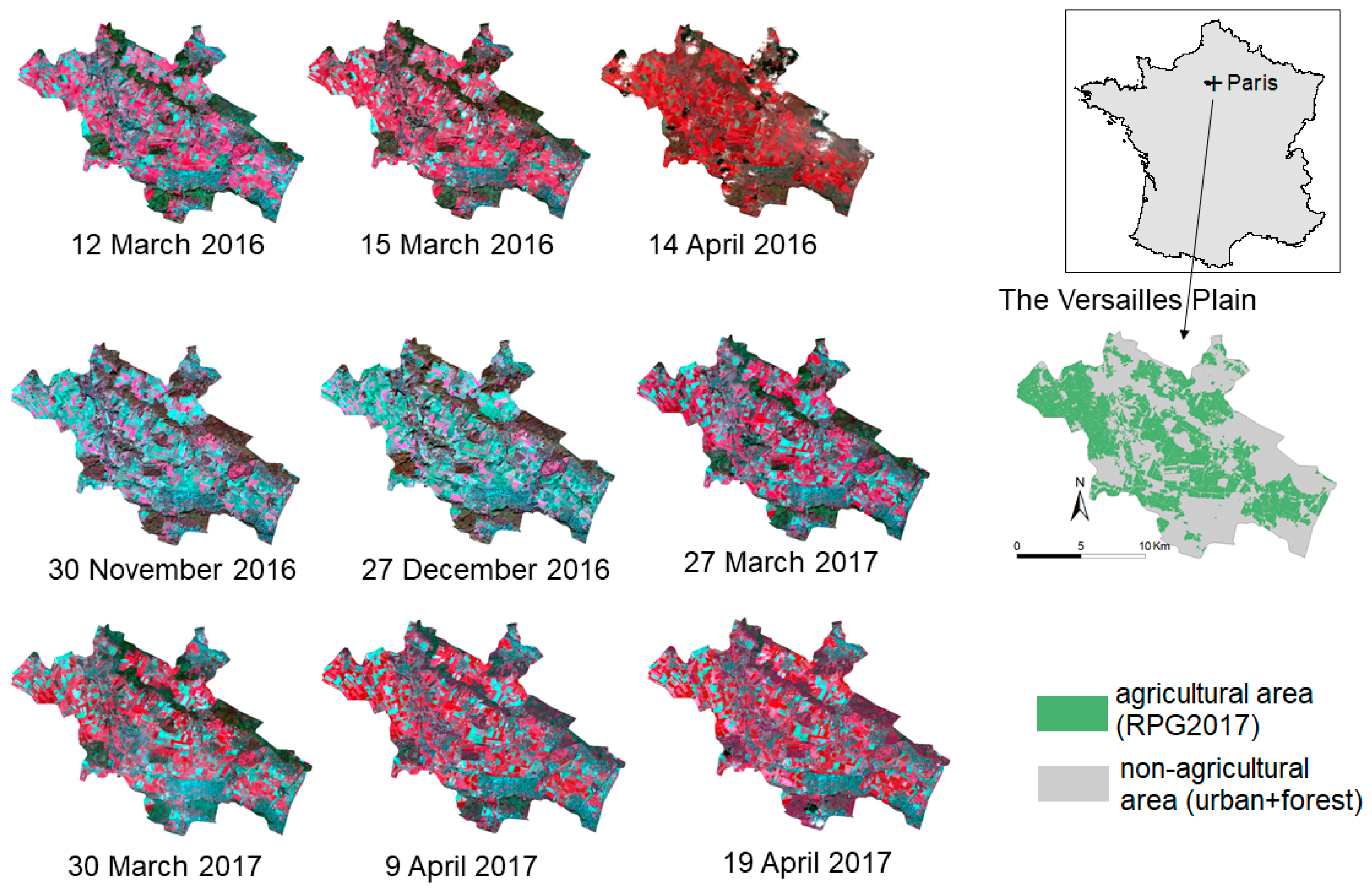
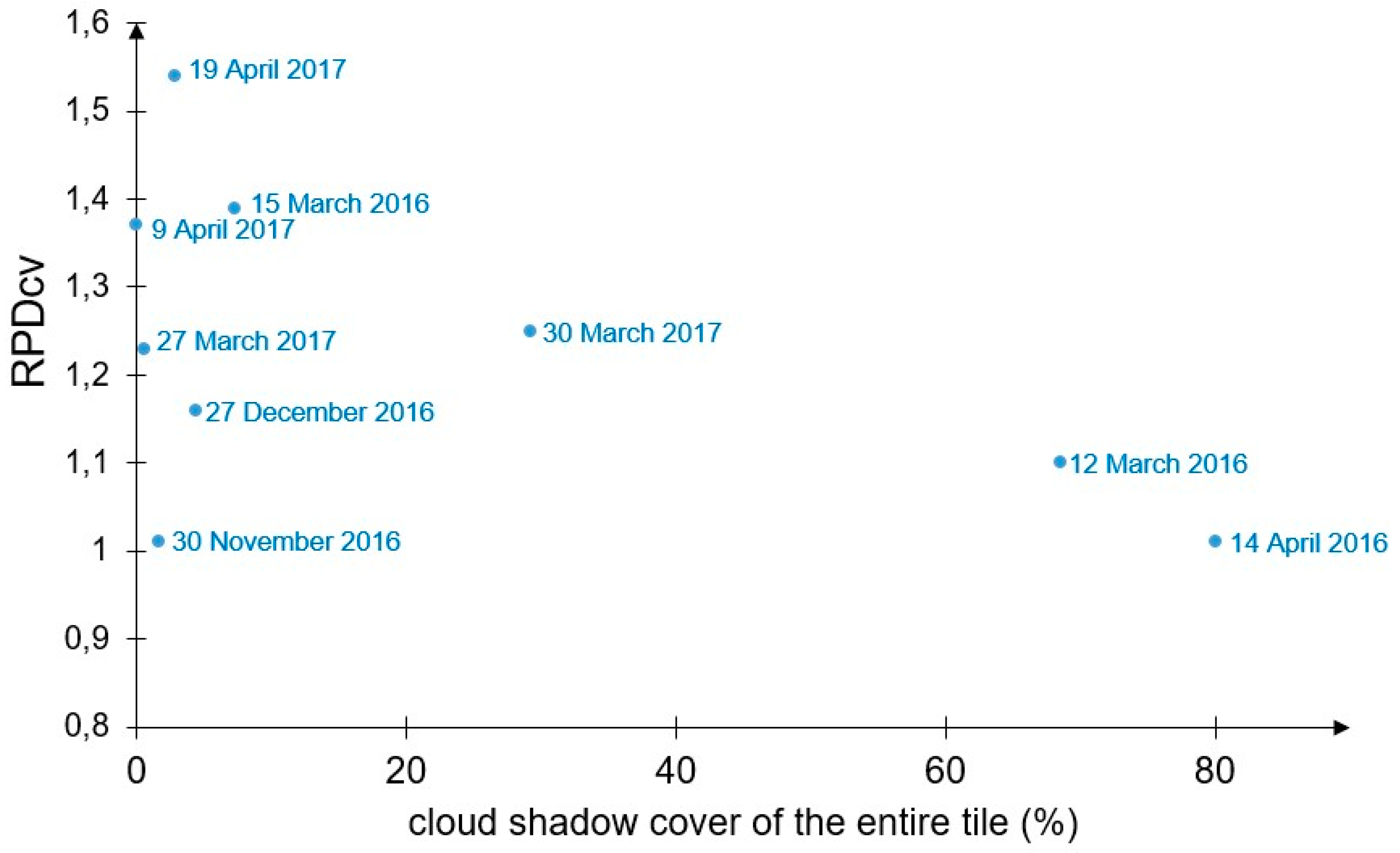
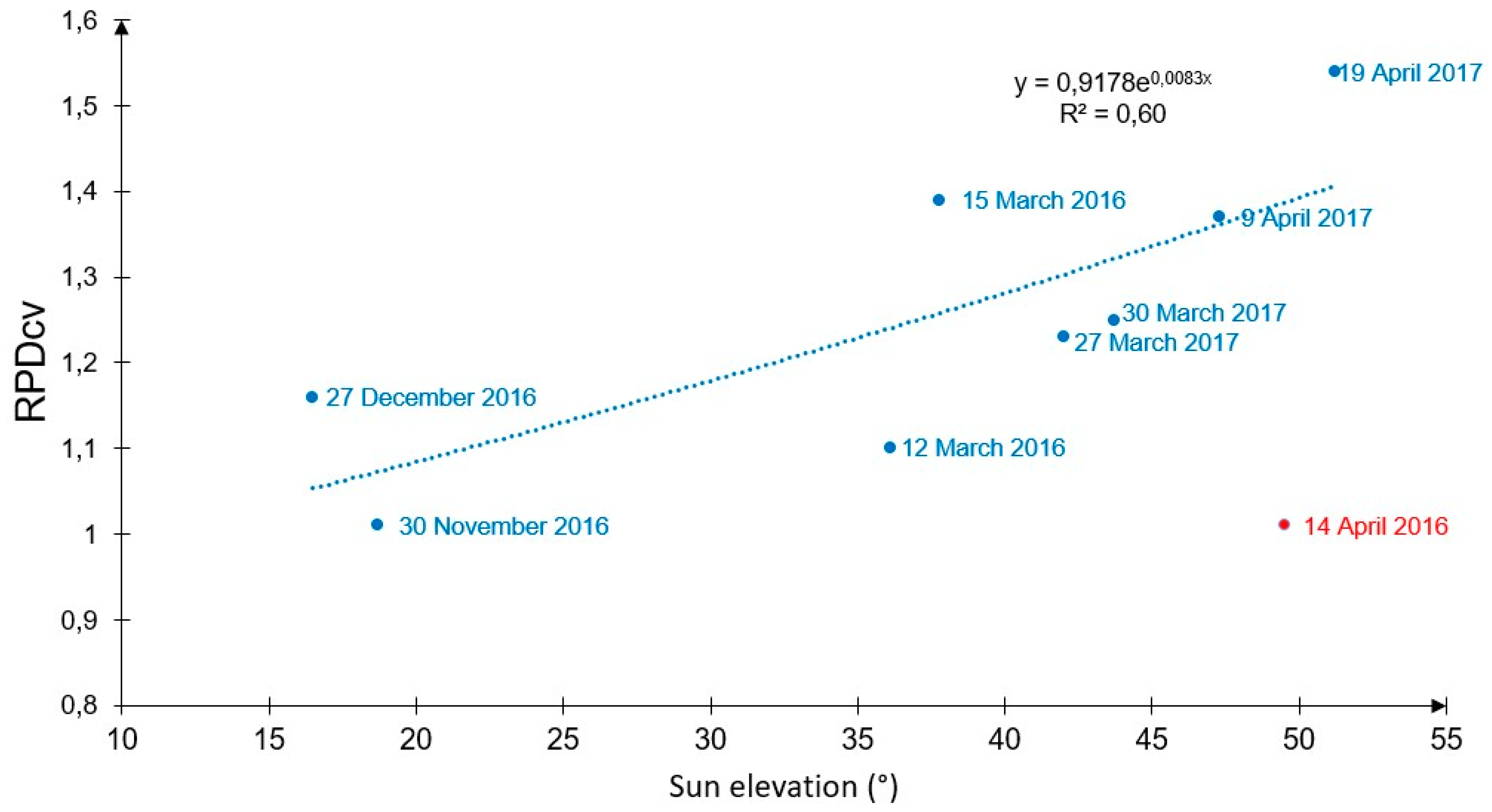
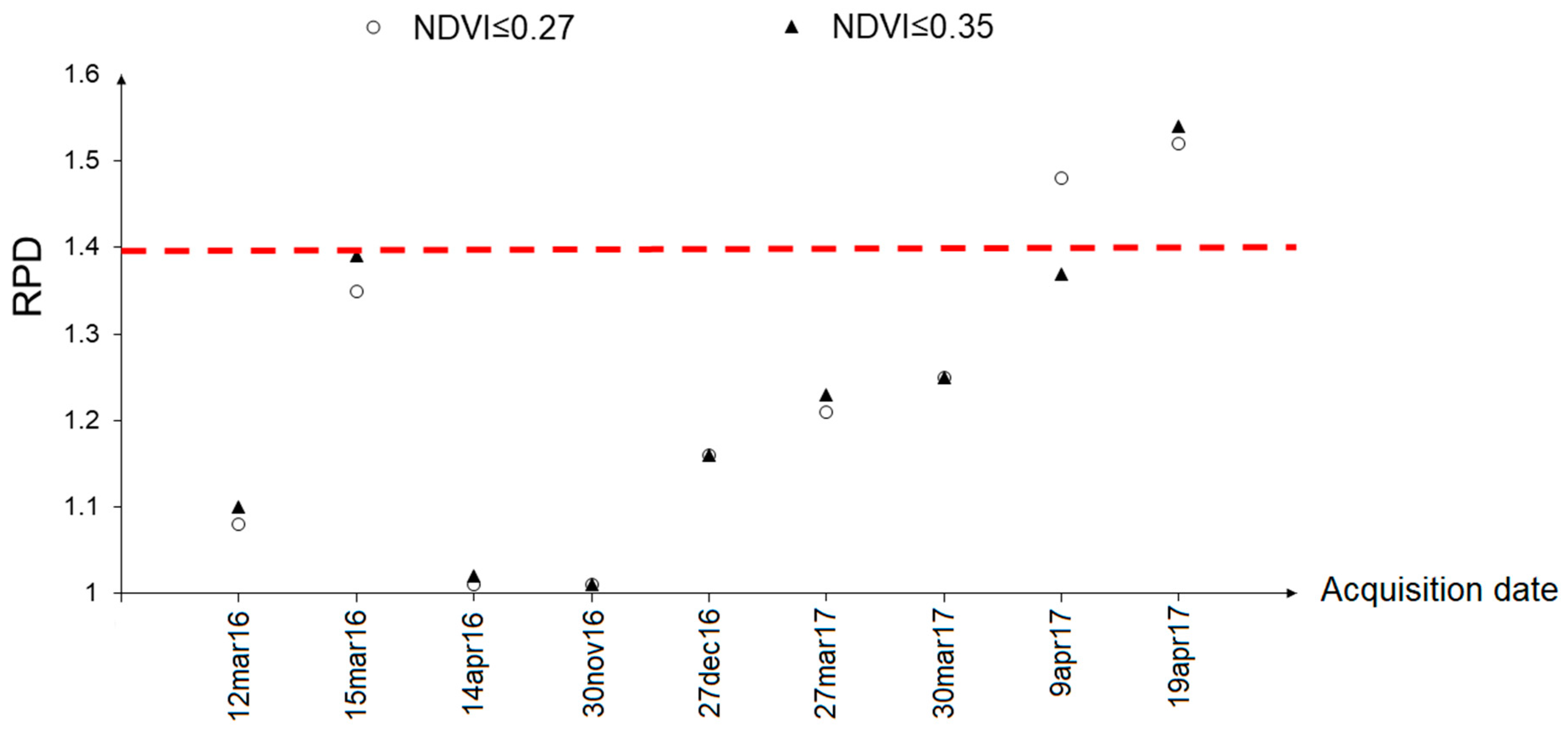
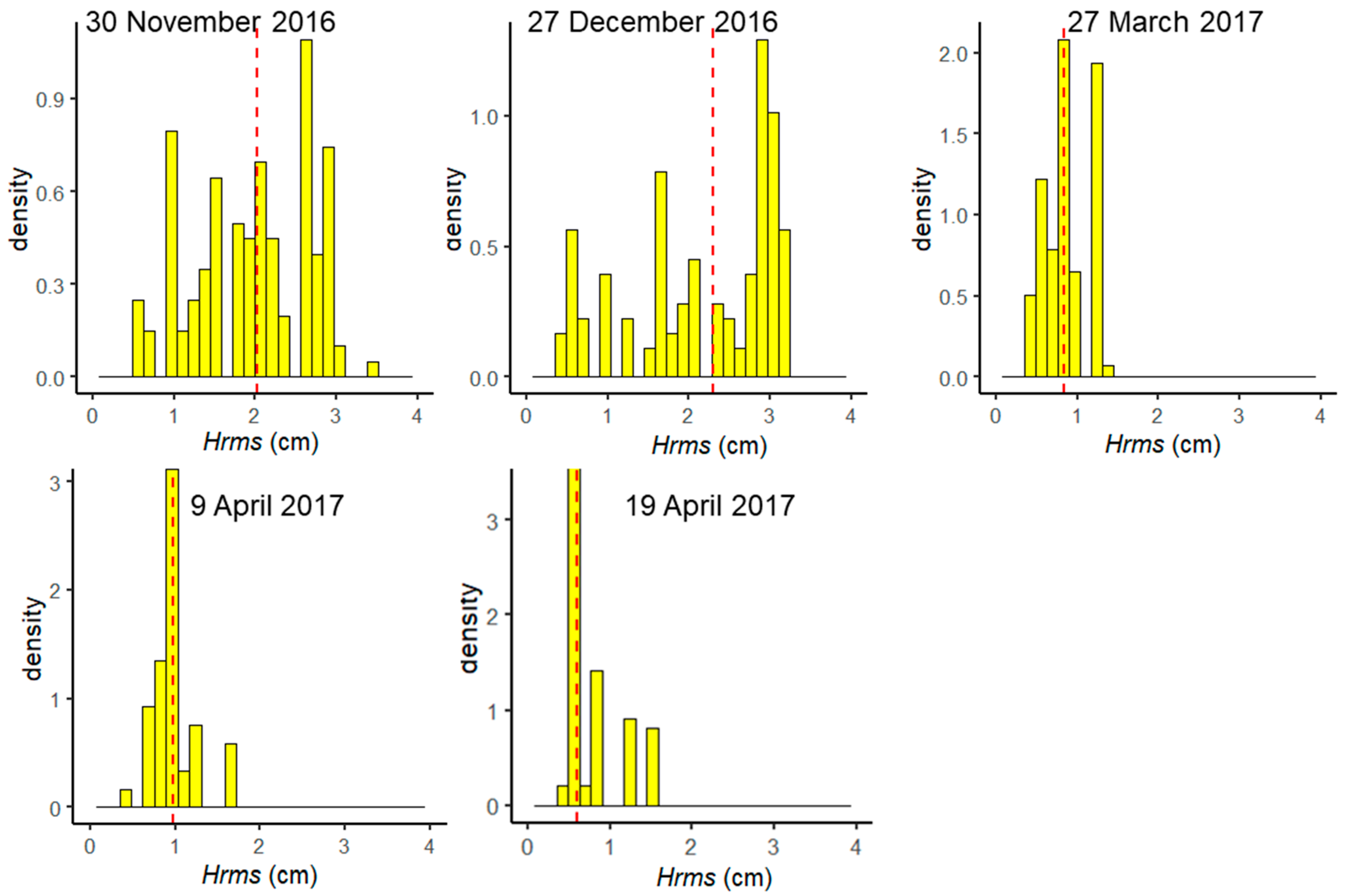
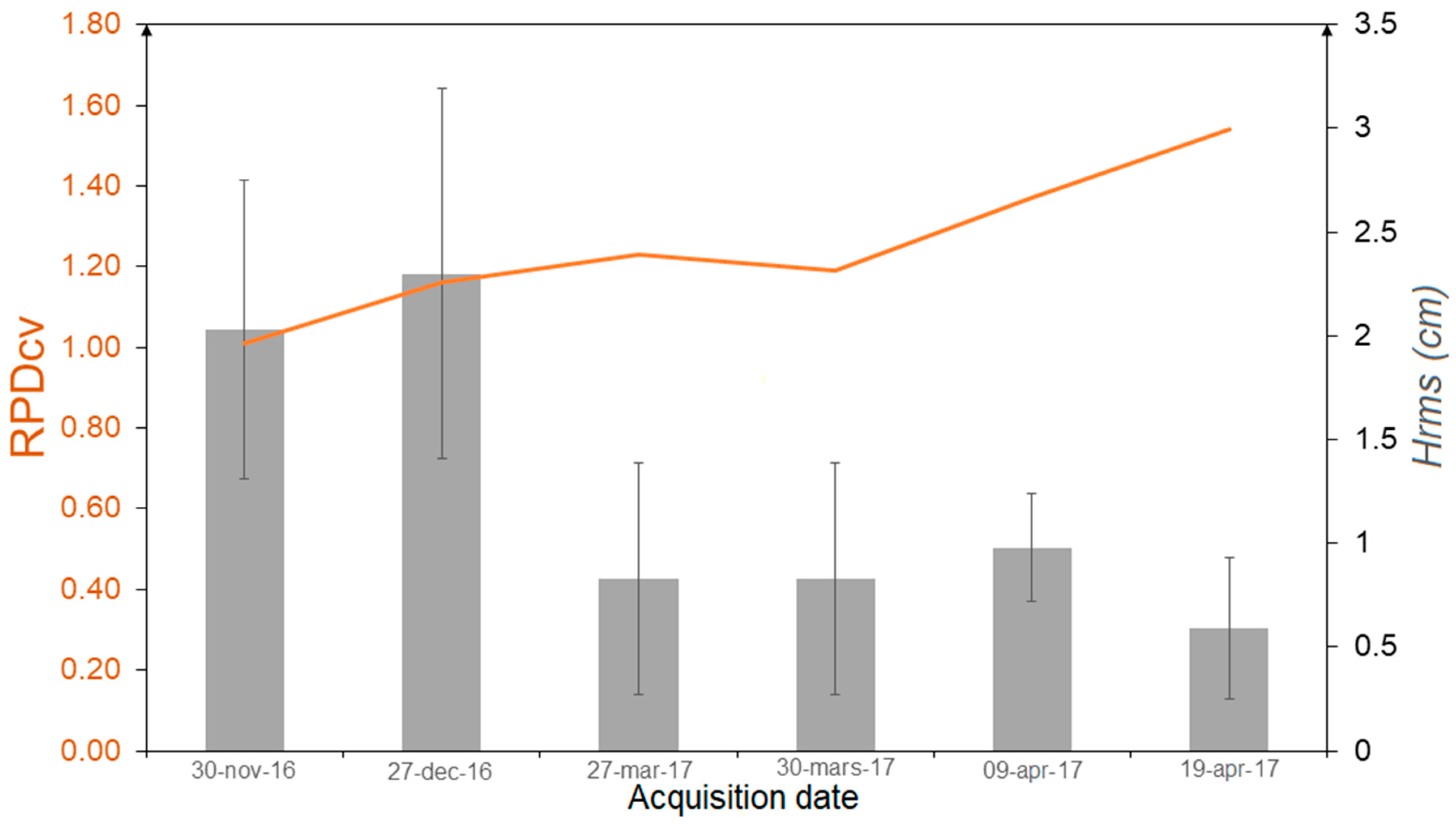
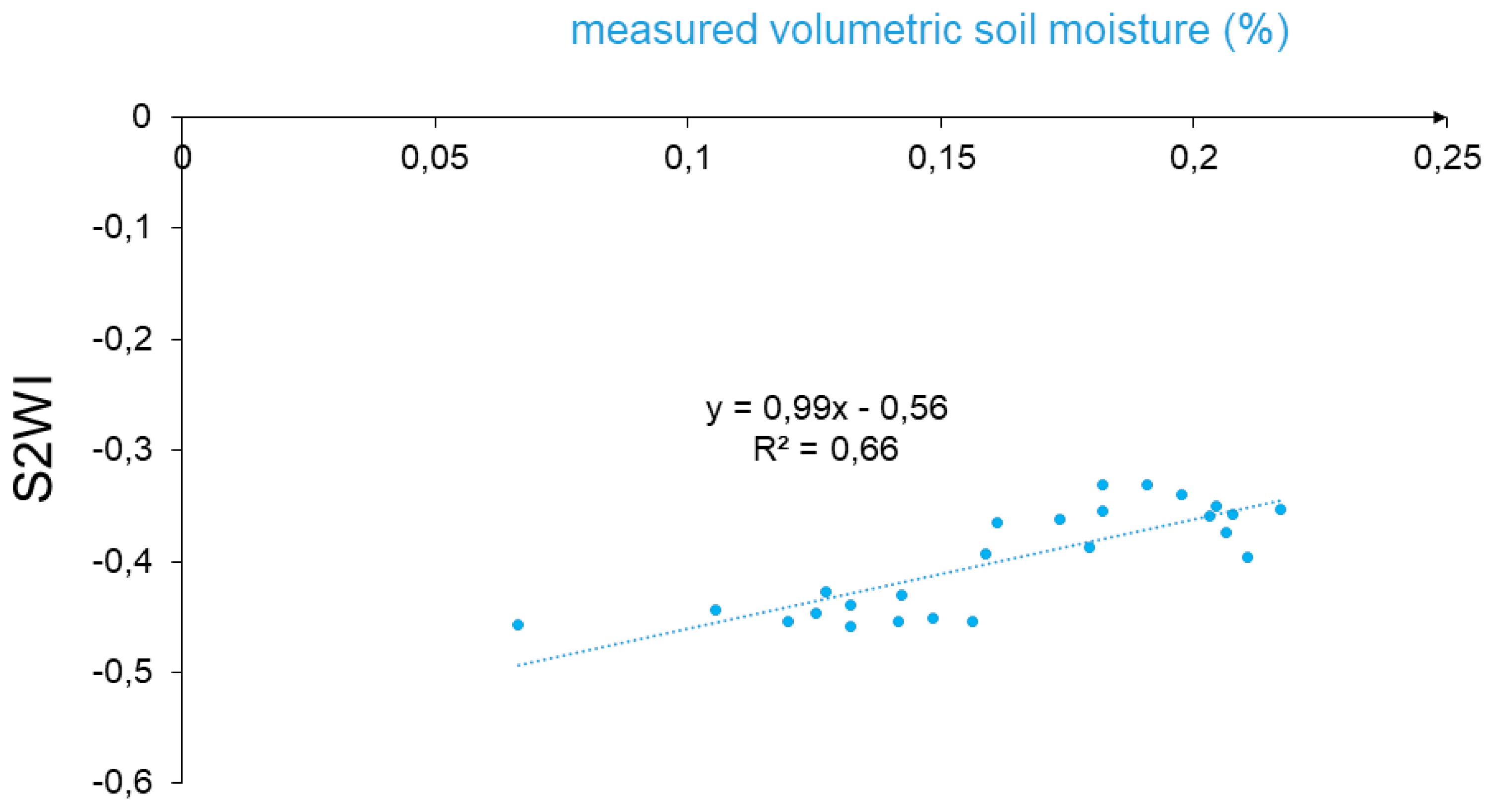
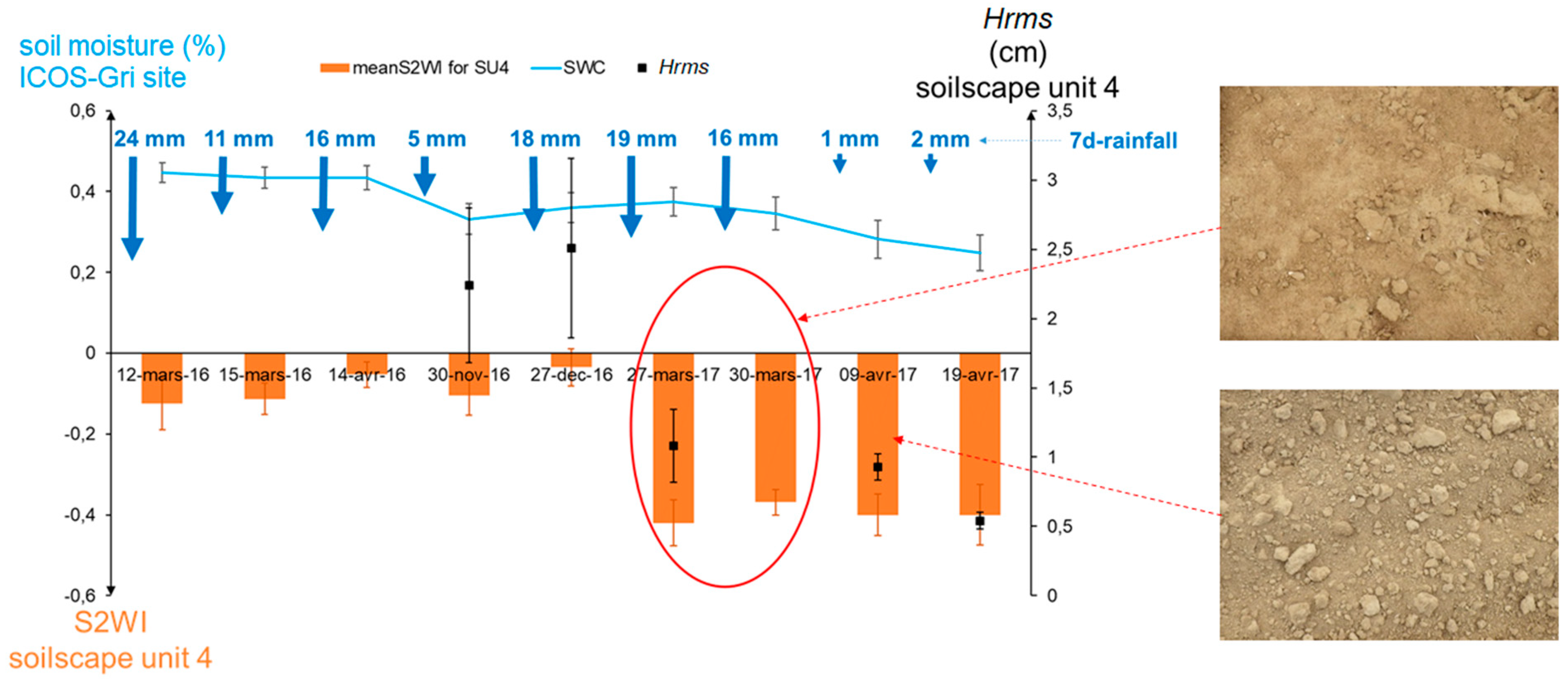
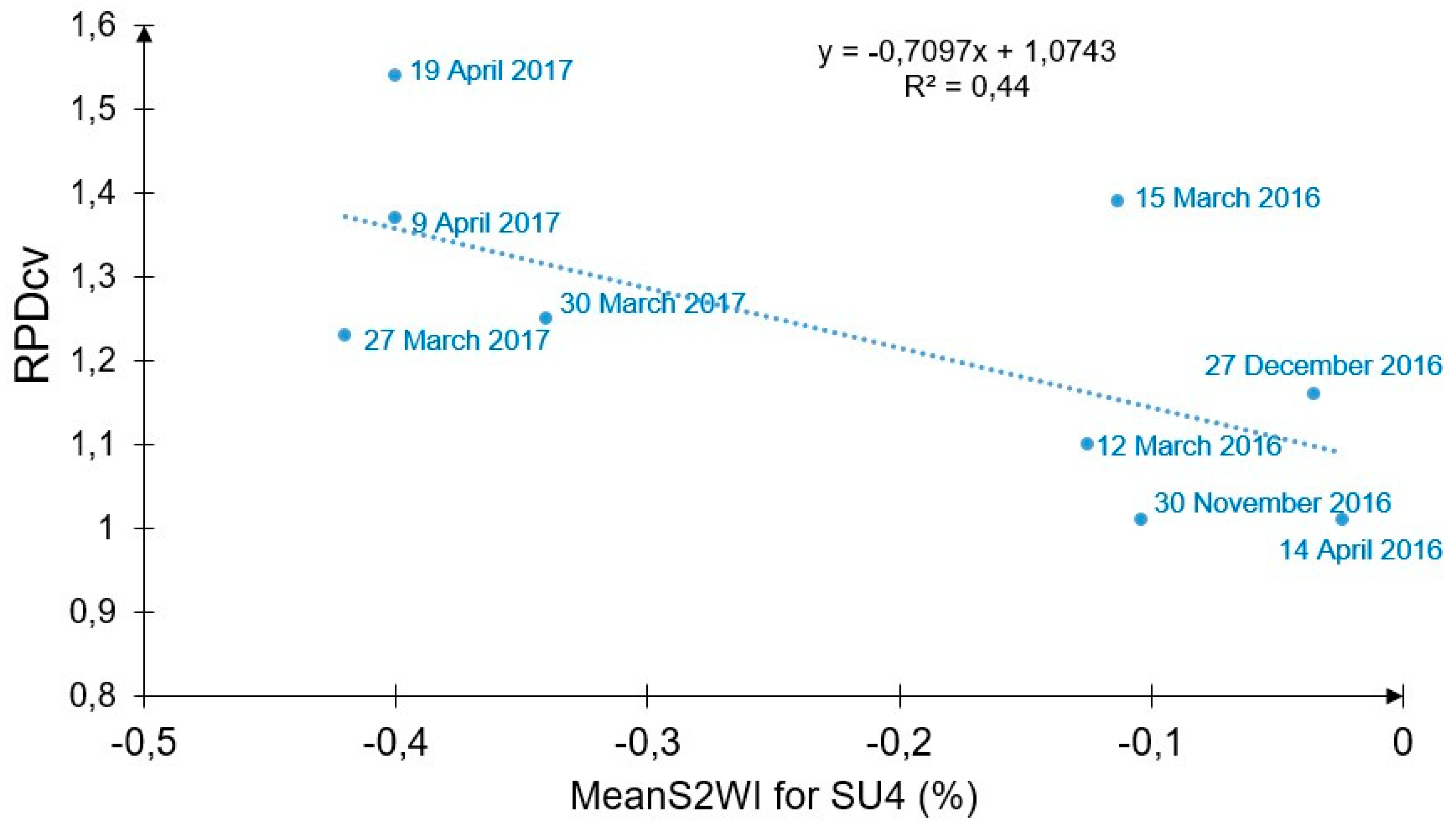
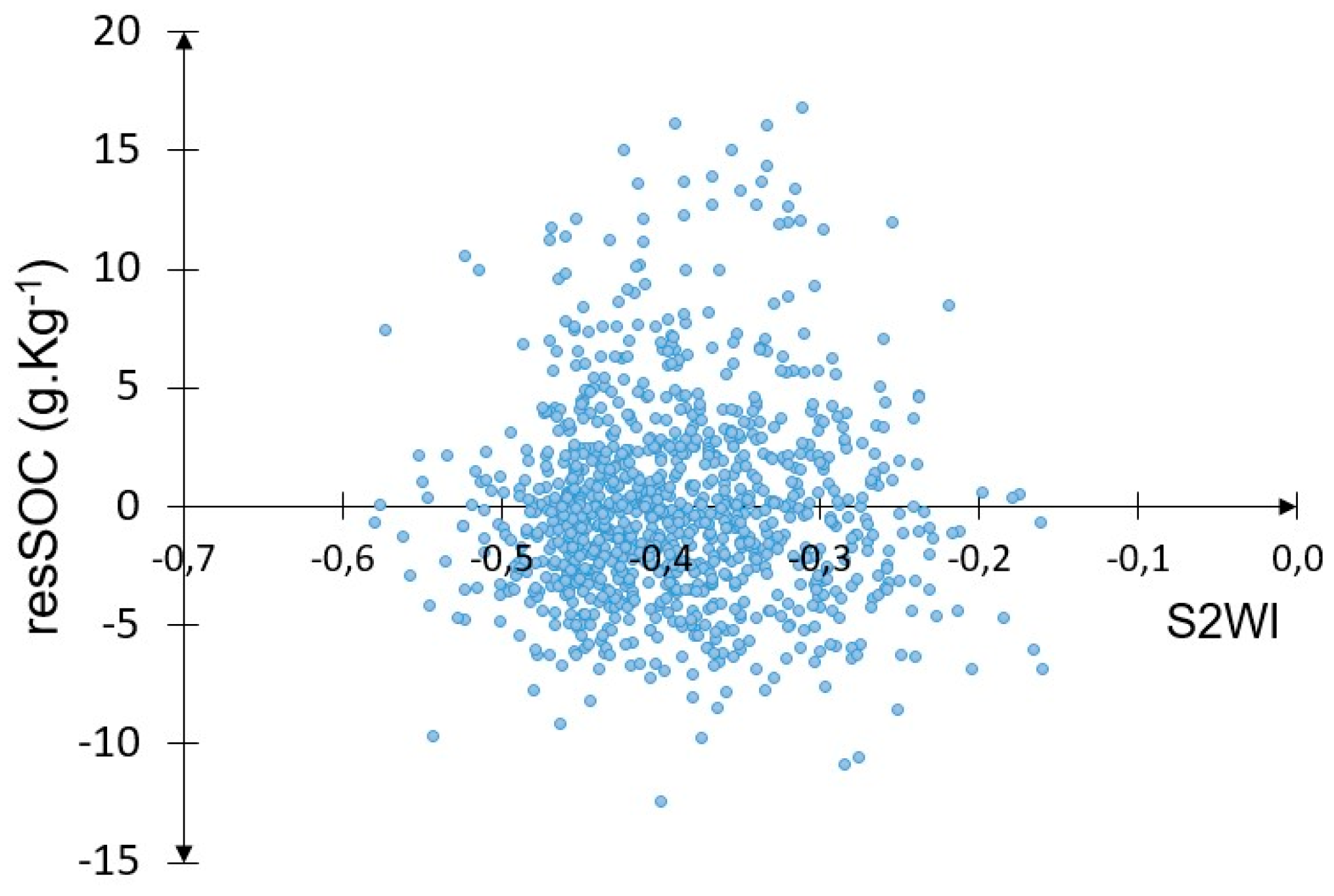
| Spectral Band | Spectral Domain | Central Wavelength (nm) | Bandwidth (nm) | Spatial Resolution (m) |
|---|---|---|---|---|
| B1 | Vis | 443 | 20 | 60 |
| B2 | Vis | 490 | 65 | 10 |
| B3 | Vis | 560 | 35 | 10 |
| B4 | Vis | 665 | 30 | 10 |
| B5 | R-edge | 705 | 15 | 20 |
| B6 | R-edge | 740 | 15 | 20 |
| B7 | R-edge | 783 | 20 | 20 |
| B8 | NIR | 842 | 115 | 10 |
| B8A | NIR | 865 | 20 | 20 |
| B9 | NIR | 945 | 20 | 60 |
| B10 | SWIR | 1380 | 30 | 60 |
| B11 | SWIR | 1610 | 90 | 20 |
| B12 | SWIR | 2190 | 180 | 20 |
| Season | Imaging Date | Time of Acquisition (U.T GMT) | Viewing Incidence Zenith Angle (°) | Sun Azimuth (°) | Sun Elevation (°) | Cloud/Shadow Cover of the Entire Tile (%) | Cloud/Shadow Cover of Study Area (%) | Date of Soil Roughness Map |
|---|---|---|---|---|---|---|---|---|
| S | 12 March 2016 | 10:50:37 | <5.1 | 160.5 | 36.1 | 68.6 | 0.2 | none |
| S | 15 March 2016 | 11:01:57 | <8.8 | 153.5 | 37.8 | 7.3 | 0 | none |
| S | 14 April 2016 | 10:57:23 | ≤8.8 | 163.5 | 49.5 | 80.0 | 46.6 | none |
| A | 30 November 2016 | 11:04:18 | ≤8.8 | 172.2 | 18.7 | 1.7 | 1.0 | 27 November 2016 |
| W | 27 December 2016 | 10:55:27 | ≤5.0 | 166.9 | 16.5 | 4.4 | 1.0 | 27 December 2016 |
| S | 27 March 2017 | 10:50:21 | ≤5.0 | 160.2 | 42.0 | 0.6 | 0.9 | 27 March 2017 |
| S | 30 March 2017 | 11:03:34 | <8.8 | 163.5 | 43.7 | 29.2 | 51.9 | none |
| S | 9 April 2017 | 11:05:29 | ≤8.8 | 163.5 | 47.3 | 0 | 0 | 8 April 2017 |
| S | 19 April 2017 | 11:06:01 | <8.8 | 163.4 | 51.2 | 2.9 | 0.9 | 20 April 2017 |
| Imaging Date | Number of Samples | Min | 1st Quartile | Median | Mean | 3rd Quartile | Max | Standard Deviation | Skewness 1 |
|---|---|---|---|---|---|---|---|---|---|
| 12 March 2016 | 83 | 7.04 | 12.65 | 16.20 | 16.81 | 20.30 | 31.90 | 5.23 | 0.45 |
| 15 March 2016 | 84 | 7.04 | 12.68 | 16.93 | 16.30 | 20.50 | 31.90 | 5.27 | 0.41 |
| 14 April 2016 | 86 | 7.04 | 12.62 | 16.30 | 16.88 | 20.35 | 31.90 | 5.16 | 0.42 |
| 30 November 2016 | 199 | 6.20 | 11.05 | 13.20 | 14.95 | 18.30 | 35.90 | 5.13 | 0.96 |
| 27 December 2016 | 173 | 6.20 | 11.10 | 13.20 | 15.17 | 18.30 | 35.90 | 5.60 | 1.23 |
| 27 March 2017 | 147 | 8.92 | 11.60 | 14.70 | 15.84 | 18.30 | 35.90 | 5.47 | 1.28 |
| 30 March 2017 | 144 | 6.38 | 11.47 | 14.70 | 15.81 | 18.30 | 35.90 | 5.55 | 1.23 |
| 9 April 2017 | 125 | 6.38 | 11.40 | 14.20 | 15.09 | 17.90 | 31.90 | 4.63 | 0.96 |
| 19 April 2017 | 122 | 6.38 | 11.40 | 14.15 | 15.08 | 17.88 | 31.90 | 4.66 | 0.97 |
| Whole dataset | 329 | 6.20 | 11.30 | 14.20 | 15.42 | 18.50 | 35.90 | 5.22 | 0.96 |
| Imaging Date | Number of Samples | Number of Latent Variables | RMSECV (g·kg−1) | R2CV | RPDCV |
|---|---|---|---|---|---|
| 12 March 2016 | 83 | 3 | 4.78 | 0.16 | 1.1 |
| 15 March 2016 | 84 | 5 | 3.79 | 0.48 | 1.4 |
| 14 April 2016 | 86 | 3 | 5.05 | 0.03 | 1.0 |
| 14 April 2016-MG2 | 54 | 1 | 5.86 | 0.005 | 1.0 |
| 30 November 2016 | 199 | 3 | 5.07 | 0.02 | 1.0 |
| 27 December 2016 | 173 | 6 | 4.82 | 0.26 | 1.2 |
| 27 December 2016-MG2 | 172 | 6 | 4.83 | 0.25 | 1.2 |
| 27 March 2017 | 147 | 4 | 4.45 | 0.33 | 1.2 |
| 30 March 2017 | 144 | 6 | 4.68 | 0.29 | 1.2 |
| 30 March 2017-MG2 | 67 | 5 | 5.44 | 0.35 | 1.3 |
| 9 April 2017 | 125 | 5 | 3.38 | 0.46 | 1.4 |
| 19 April 2017 | 122 | 6 | 3.02 | 0.58 | 1.5 |
© 2019 by the authors. Licensee MDPI, Basel, Switzerland. This article is an open access article distributed under the terms and conditions of the Creative Commons Attribution (CC BY) license (http://creativecommons.org/licenses/by/4.0/).
Share and Cite
Vaudour, E.; Gomez, C.; Loiseau, T.; Baghdadi, N.; Loubet, B.; Arrouays, D.; Ali, L.; Lagacherie, P. The Impact of Acquisition Date on the Prediction Performance of Topsoil Organic Carbon from Sentinel-2 for Croplands. Remote Sens. 2019, 11, 2143. https://doi.org/10.3390/rs11182143
Vaudour E, Gomez C, Loiseau T, Baghdadi N, Loubet B, Arrouays D, Ali L, Lagacherie P. The Impact of Acquisition Date on the Prediction Performance of Topsoil Organic Carbon from Sentinel-2 for Croplands. Remote Sensing. 2019; 11(18):2143. https://doi.org/10.3390/rs11182143
Chicago/Turabian StyleVaudour, Emmanuelle, Cécile Gomez, Thomas Loiseau, Nicolas Baghdadi, Benjamin Loubet, Dominique Arrouays, Leïla Ali, and Philippe Lagacherie. 2019. "The Impact of Acquisition Date on the Prediction Performance of Topsoil Organic Carbon from Sentinel-2 for Croplands" Remote Sensing 11, no. 18: 2143. https://doi.org/10.3390/rs11182143
APA StyleVaudour, E., Gomez, C., Loiseau, T., Baghdadi, N., Loubet, B., Arrouays, D., Ali, L., & Lagacherie, P. (2019). The Impact of Acquisition Date on the Prediction Performance of Topsoil Organic Carbon from Sentinel-2 for Croplands. Remote Sensing, 11(18), 2143. https://doi.org/10.3390/rs11182143








